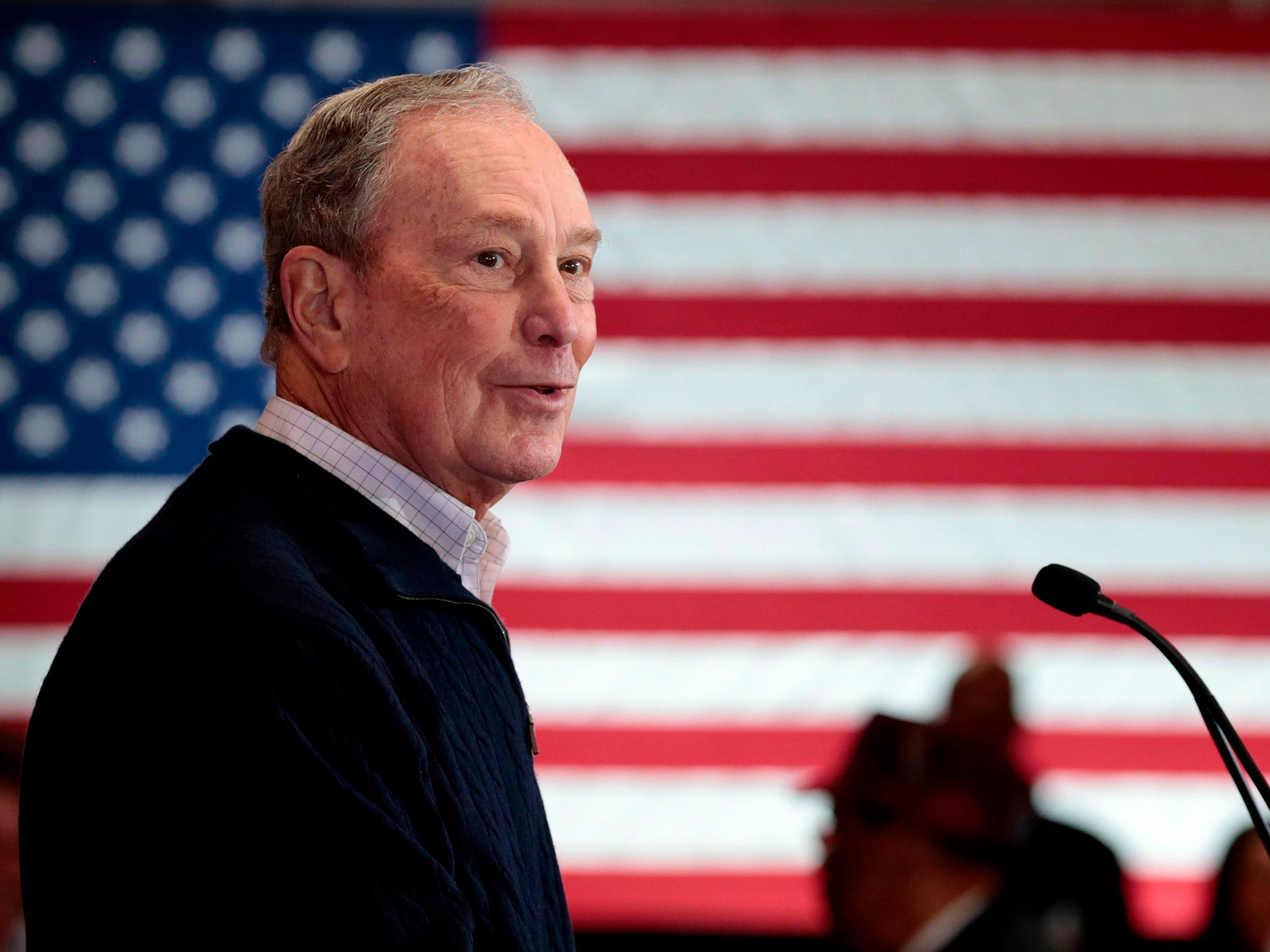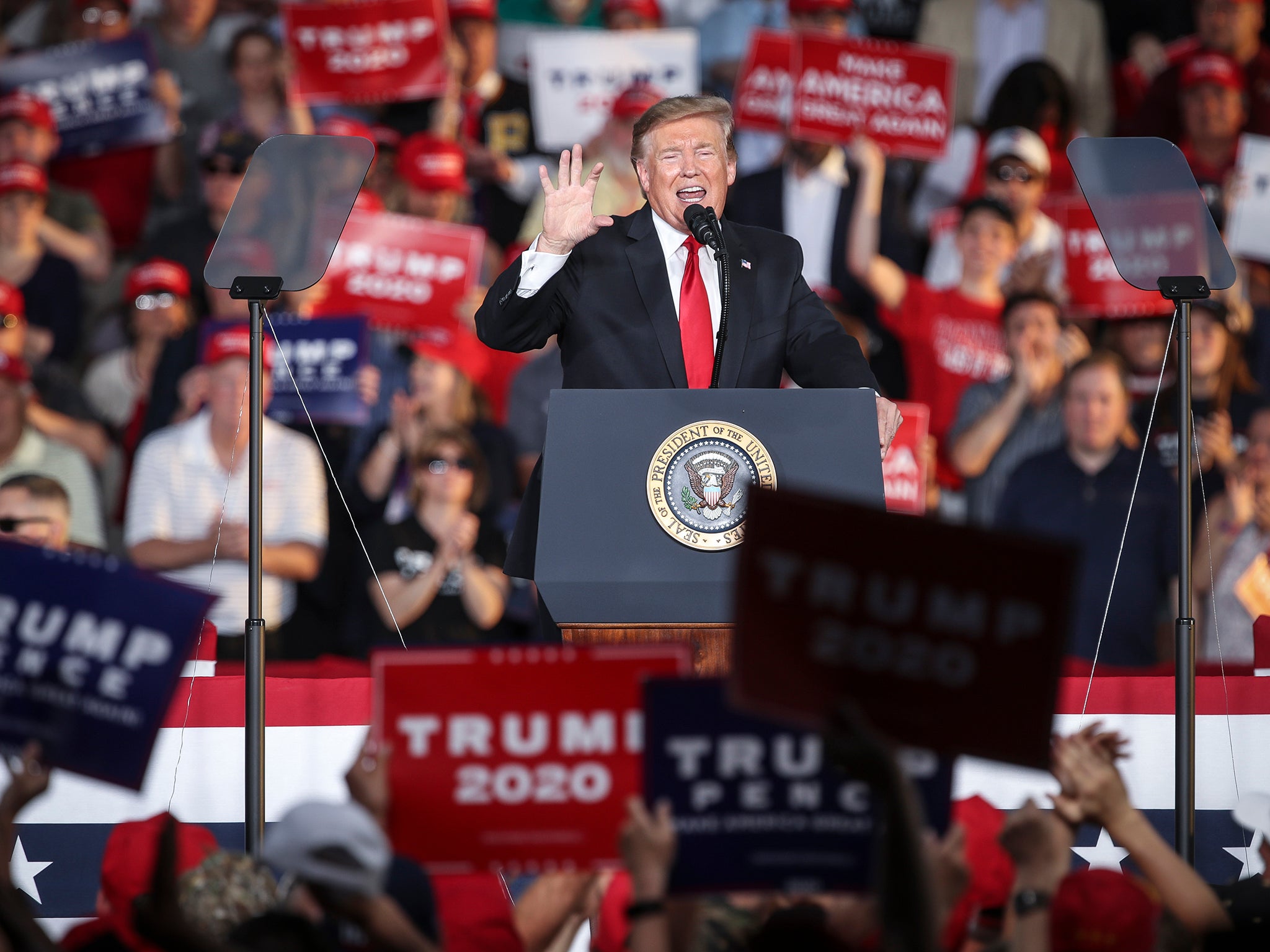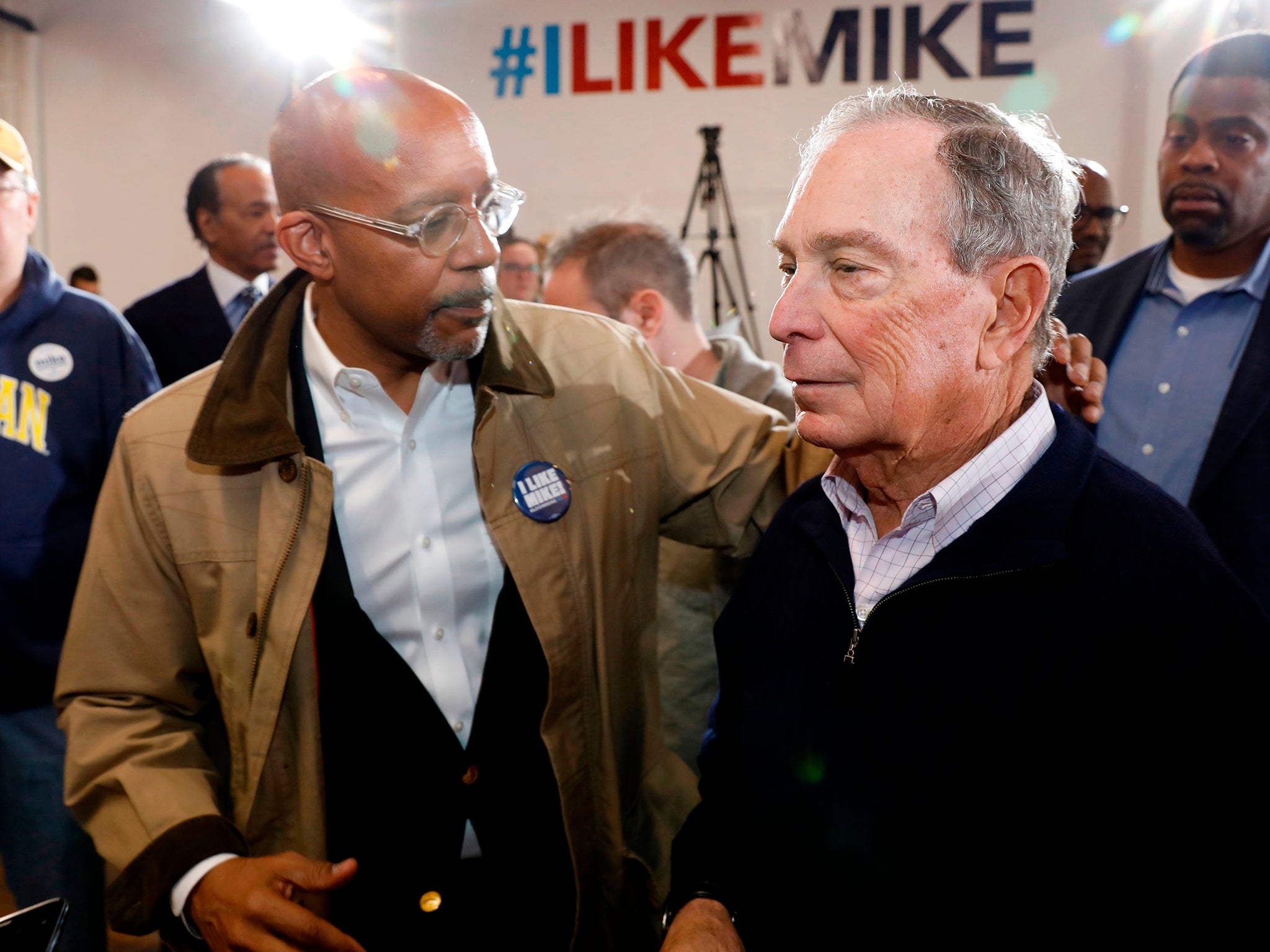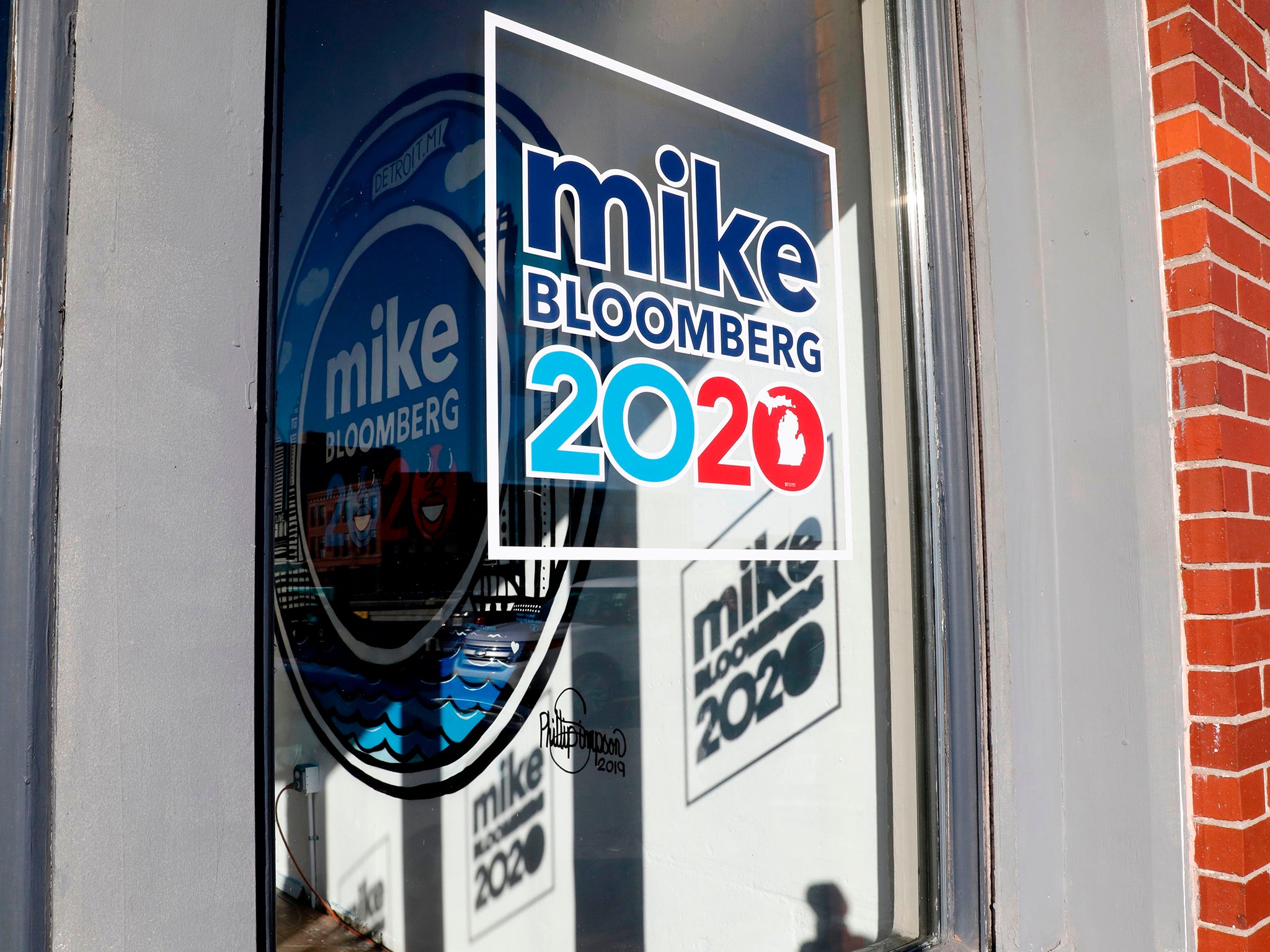Michael Bloomberg spending millions in 2020 advertising war against Trump
Effort will target seven key battlegrounds where US president has an edge

Hillary Clinton tried. So did 16 rival Republicans. And after hundreds of millions of dollars were spent on ads attacking Donald Trump in 2016, the results were the same: They never did much damage.
Now Michael R Bloomberg is trying — his way — spending millions each week in an online advertising onslaught that is guided by polling and data that he and his advisers believe provide unique insight into the president’s vulnerabilities.
The effort, which is targeting seven battleground states where polls show Mr Trump is likely to be competitive in November, is just one piece of an advertising campaign that is unrivalled in scope and scale. On Facebook and Google alone, where Mr Bloomberg is most focused on attacking the president, he has spent $18m (£13.7m) on ads in the last month, according to Acronym, a digital messaging firm that works with Democrats.
That is on top of the $128m (£97m) the Bloomberg campaign has spent on television ads, according to Advertising Analytics, an independent firm, which projects that Bloomberg is likely to spend a combined $300m (£228m) to $400m (£304m) on advertising across all media before the Super Tuesday primaries in early March.
Those amounts dwarf the ad budgets of his rivals, and he is spending at a faster clip than past presidential campaigns as well. Mr Bloomberg is also already spending more than the Trump campaign each week to reach voters online. And if the $400m estimate holds, that would be about the same as what president Barack Obama’s campaign spent on advertising over the course of the entire general election in 2012.
The ads amount to a huge bet by the Bloomberg campaign that there are enough Americans who are not too fixed in their opinions of Mr Trump and can be swayed by the ads’ indictment of his conduct and character.
None of these assumptions are safe in a political environment that is increasingly bifurcated along partisan lines and where, for many voters, information from “the other side” is instantly suspect. But Mr Bloomberg’s aides think it is imperative to flood voters with attacks on the president before it is too late — a lesson Republicans learned in 2016 when they initially spent most of their ad budgets during the primaries tearing into one another while ignoring Mr Trump.
In one new Bloomberg campaign ad, a man from Michigan refers to the spending in the Democratic primary: “All this effort and all this money and none of it goes to help the one election that really matters?” The campaign plans to run the ad online in Super Tuesday primary states.
Another man featured in the ad bemoans the fact that the Trump campaign is so focused on Pennsylvania but that none of the Democrats seem to be. “By the looks of it, he’s trying to win Pennsylvania once again. He’s here all the time,” the man says.
In swing states like Wisconsin and Pennsylvania that are likely to decide whether Mr Trump gets re-elected, ads from the president’s campaign and friendly outside groups have been, for the most part, the only paid messages that voters have seen about him. Mr Bloomberg’s campaign is focusing its efforts there, hoping to erode Mr Trump’s standing.
“I’ve been telling anyone who will listen, Trump is winning,” said Kevin Sheekey, the campaign manager for Mr Bloomberg, who argued that the lack of anti-Trump advertising essentially means “he is running unopposed in swing states”.
In interviews, Mr Bloomberg’s top strategists described how they think they can undermine Mr Trump’s standing with voters who are open to reconsidering their support for him. According to the campaign’s data, this is somewhere between 10 per cent to 15 per cent of the people who voted for him in 2016.

Mr Bloomberg’s aides say their data generally shows that these people tend to express disappointment about promises Mr Trump has failed to keep on issues like rebuilding the nation’s infrastructure — an especially potent concern in places like Michigan.
In most states, they are upset with the president’s push to repeal the Affordable Care Act without putting forward a Republican alternative, which voters view as jeopardising their health coverage. They view his response to several mass shootings during his term as lacking urgency and seriousness, particularly in the suburbs around Detroit and Philadelphia, the Bloomberg data shows.
And many of them report feelings of exasperation and exhaustion after three years of what seems like daily, head-spinning stories about Mr Trump, his impulsivity, dysfunction inside his administration, and partisan squabbling in Washington that has in some cases bled into their lives at home and work.
“With the percentage of the electorate that is open to reconsidering, there is a tax on them that they want to eliminate — and that tax is on their attention,” said Gary Briggs, who left Facebook as its chief marketing officer last year to join Mr Bloomberg’s company and is now advising his presidential campaign.
The messages the Bloomberg campaign is using in ads on social media and other websites are tailored to this sense of exhaustion. “Say no to chaos,” says one that appeared on Facebook in North Carolina.
“Another tweet. Another lie. Trump has tweeted thousands of false statements — causing chaos and embarrassing our country,” reads another, depicting a picture of a man covering his face in evident despair as he stands in what appears to be a soybean field. (Soybean farmers have been among the most affected by Mr Trump’s tariffs on Chinese goods.)
Others are more issue-specific and play to a notion that Bloomberg strategists say has tested well in their research: The president is looking out for the interests of big corporations and the wealthy, despite promises to improve the lives of working-class Americans.

The seven states the Bloomberg campaign has chosen are some of the most competitive, like Wisconsin and Florida, and others where Democrats believe they can chip away at Republican dominance, like Texas and Arizona. Rounding out the list are Michigan, Pennsylvania and North Carolina.
The Trump campaign has responded aggressively to Mr Bloomberg’s entry into the race, going so far as to bar Bloomberg News reporters from its rallies and events because the outlet has said it would not conduct investigative reporting on Mr Bloomberg’s rivals for the Democratic nomination. Mr Trump has belittled the former mayor and dismissed him as a threat saying, “little Michael will fail”.
Finding the most incisive way to attack a sitting president is extremely difficult for a variety of reasons. Not only does the president enjoy the power and platform of incumbency, but by and large Americans have already formed their views over the course of the first term.
Larry McCarthy, a Republican ad-maker who wrote many of the super PAC ads that attempted to undercut president Barack Obama’s popularity with swing voters in 2012, said he thinks his ads were not as effective “because many voters had already made a judgment about Obama. A significant number of voters, in our data, did not like Obama policies but did not think he was a bad guy”.
With Mr Trump, the opposite is true. Polls show that most Americans approve of his handling of the economy, but they consistently give him low job approval ratings, saying that they do not think he is honest.
And public polls further show that he stands an even chance of winning many battleground states against a variety of the Democratic candidates, which the Bloomberg campaign said tracks with its internal data.
With the ads, the Bloomberg campaign is also walking a fine line between trying to undercut Mr Trump and turning off voters who may not like the president but do not want to dwell on him.

“There is a kind of anxiety that he creates,” Howard Wolfson, one of Mr Bloomberg’s longtime top advisers, said about Mr Trump. “This is real for people,” he added, acknowledging the contradictory factors. “There’s a bit of ‘Leave us alone.’”
The Bloomberg campaign said it had produced 160 versions of its ads on social media alone, reaching 15.5 million people in the first two weeks of December.
“Michael Bloomberg’s fledgling campaign has now spent more on Google and YouTube in the past month than the Trump campaign has spent all year,” Acronym said in a recent analysis of the race.
The ability to pour that much money into ads not only enables Mr Bloomberg’s campaign to pump out millions of messages a week, it allows for more precise targeting to individual groups of uncommitted voters — whether that’s women in the suburbs concerned about gun violence or more fiscally conservative people who are alarmed by the nation’s rapidly expanding deficit.
One of the most potentially significant impacts of the Bloomberg strategy, said Ken Goldstein, a professor of politics at the University of San Francisco and an expert in political advertising, could be how he is filling the void in places where pro-Trump ads are dominant.
In a new study Goldstein conducted with a group of other academics who specialise in political messaging, he said they found that in 2016 the lack of advertising from Hillary Clinton’s campaign seemed to contribute to lower turnout among voters favourable to her. Democrats with a lower propensity of voting in Michigan and Wisconsin, the study found, were less likely to turn out in areas where Mr Trump was investing heavily online but where Mr Clinton was not advertising.
“The overall impact was modest, to be sure,” Mr Goldstein said. “But Trump’s margin of victory in Michigan and Wisconsin was also extremely modest.”
In addition to the hard-hitting critiques of Mr Trump and his leadership, Mr Bloomberg’s ads are designed to send a positive message about the former mayor that reaches Democrats in the primary. And it is those voters, no doubt, who need to be convinced first in order for Mr Bloomberg to politically benefit from his huge investment in anti-Trump advertising.
“Sometimes it’s easiest to define yourself by what you are not,” said Todd Harris, a Republican messaging strategist who has worked on several presidential campaigns, most recently for senator Marco Rubio of Florida. These ads, he said, are “all about Mike Bloomberg introducing himself to primary voters as someone who dislikes Trump as much as they do”.
The New York
Join our commenting forum
Join thought-provoking conversations, follow other Independent readers and see their replies
Comments